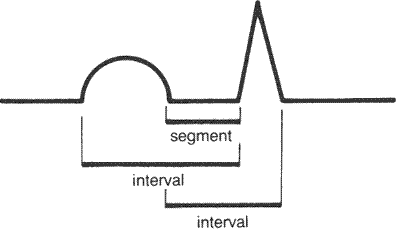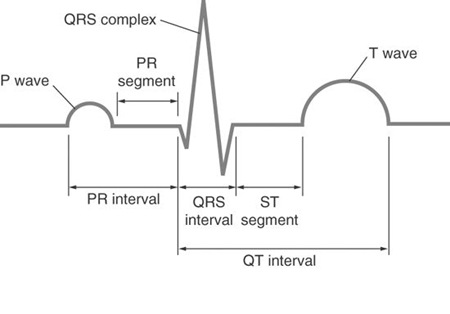
basic ecg wave consists of waves :
P wave:represents atrial depolarisation
QRS complex:ventricular depolarisation
ST segment,T wave & U wave:ventricular repolarisation.
now you may have a doubt of where the atrial repolarisation has gone?answer is the atrial ST segment(STa) & atrial T wave(Ta) are generally not observed on normal ecg because of their low amplitudes.
exception: acute pericarditis causes PR segment deviation.
A segment is a straight line connecting two waves, whereas an interval encompasses at least one wave plus the connecting straight line.


WE will discuss about "Vital signs" of the ECG.
As soon as you see an ECG,scan for these 4 things in the first look itself .they are:
- heart rate
- PR interval
- QRS width
- QT interval.
Heart rate:
normal heart rate :60-100 beats/min.
if more than 100 beats/min-tachycardia
if less than 60 beats/min-bradycardia
we will discuss the conditions which cause them in future posts.now we will learn to measure it at one glance.
2 methods:
Box counting methods-if heart rate is regular
Count the number of large boxes(0.2 sec boxes) b/w 2 successive QRS complexes & divide 300 by it.{300 * 0.2=60 & heart rate is measured for 60 sec}
example-in the below ecg no. of large boxes b/w 2 successive QRScomplexes is 3.
therefore heart rate=300/3=100 beats/min

if u want to measure even more accurately ,count the no. of small(0.0 sec) boxes b/w 2 successive QRScomplexes and divide 1500 with it.{1500*0.04=60}
QRS counting methods-if heart rate is irregular.
Count the no. of QRS complexes in 6 second intervals & then multiply it by 10.
The PR Interval:
- The PR interval is the time from the beginning of the P wave until the beginning of the QRS complex.
- it is normally between 0.12 and 0.2 seconds (three to five small boxes) in length.
- The PR interval may be prolonged when conduction of the electrical wave through the AV node is slow. This may be seen with degenerative disease of the node, or with digoxin, hyperkalemia, hypercalcemia, or hypothermia.
- The PR interval may be unusually short when conduction is rapid. A mildly short PR interval may be seen with hypokalemia or hypocalcemia. An artificially-short PR interval occurs when the QRS complex begins early, as happens with an extra conducting bundle — Wolff-Parkinson-White Syndrome (WPW).
- Following the P wave is the PR segment. (NOTE: the PR segment and the PR interval are NOT the same thing.) The PR segment is not routinely measured, but may be commented on if it is depressed or elevated. During the PR segment, the electrical wave moves slowly through the atrioventricular (AV) node. This activity is not seen on the ECG.
if PR interval > 0.2 sec -called "First degree heart block"
The QRS width:
- If the first deflection of the QRS is downward, it’s called a Q wave. The Q wave represents activation of the ventricular septum.
- The first upward deflection of the QRS is called the R wave. Most of the ventricle is activated during the R wave.
- The S wave is any downward deflection following the R wave.
- If a second upward deflection is seen, it’s called an R-prime wave(R' wave).
- QRS complexes may be described by naming the waves that form them. For example, a complex with an R, an S, and an R’ is called an RSR’ complex.
clinical aspects:
- Q waves may be normal. For example in lead I, a Q less than 1/4 of the R height, and less than one box wide, is considered normal. This is the early activation of the septum. This activation goes left — away from lead I — and is therefore negative on the ECG. “Septal Qs” are normal in I, F, V5 and V6. Qs are also generally innocent in lead III and lead V1 if no other abnormality is seen.
- Q waves are “significant” if they are greater than 1 box in width (longer than 0.04 msec) OR are larger than 1/4 of the R wave. Significant Q waves indicate either myocardial infarction or obstructive septal hypertrophy (IHSS).
- The R wave may be prolonged if the ventricle is enlarged, and may be abnormally high (indicating strong voltage) if the ventricular muscle tissue is hypertrophied.
- Like the R wave, an abnormally large S wave may indicate hypertrophy of the ventricle
- R-prime waves are never normal, but indicate a problem in the ventricular conduction system.
QT interval:
The QT interval is the time from the beginning of the QRS complex until the end of the T wave. The “normal” QT length varies with heart rate. Very fast rates shorten the QT length.
QT interval should be measured in the ECG lead that shows the longest interval.
as it changes with heart rate ,a rate corrected QT interval(QTc) has been devised.

- Bazett equation=QTc=QT/square root of RR interval.
- RR=b/w 2 successive R waves.
- normally QTc is less than or equal to about 0.44 sec.
clinical aspects:
QT interval shortened-
- digitalis(in therapeutic doses)
- hypercalcemia.
QT prolongation predisposes to Torsade de Pointes(distinctive polymorphic ventricular tachycardia in which the QRS amplitude varies and the QRS complexes appear to twist around the baseline)
QT prologation:
1.congenital(hereditary) long QT syndromes:
- Romano-Ward syndrome(autosomal dominant)
- Jervell & Lange-Nielson syndrome(autosomal recessive with congenital deafness)
2.Acquired long Qt syndromes:
a.electrolyte abnormalities-
- hypocalcemia
- hypokalemia
- hypomagnesemia
b.drugs:
- class 1A or 3 antiarrhythmic agents(amiodarone,disopyramide,dofetilide,ibutilide,procainamide,quinidine,sotalol)
- antihistamines(astemizole,terfenadine)
- antianginal(bepridil)
- antimalarial(chloroquine,halofantrine)
- psychotropics(phenothiazines,tricyclic antidepressants,haloperidol)
- Gastrointestinal stimulant(cisapride)
- antinausea(domperidone,droperidol)
- antibiotics(clarithromycin,erythromycin,pentamidine,sparfloxacin)
- antilipemic(probucol)
- opiate agonist(methadone.levomethadyl)
- diuretic(indapamide)
c.myocardial ischemia or infarction.
d.cerebrovascular injury
e.systemic hypothermia.
f.bradyarrhythmias.
g.others:
- liquid protein diets
- starvation
- myocarditis
- arsenic poisoning
IN the next post we will discuss about P wave,ST segment,T wave,U wave & also about ECG leads.
4 comments:
How can I explain this to the world that there is a man who can cure HERPES, I was diagnosed for the past 1 year I have being into HERPES since 1 year, so I decide to look for help in the internet then I found a post write about this great man called DR. Yakubu , people say good thing about him that this man have cured, a lot of people in the internet, him has power's to cure HSV1 AND HSV2 I don’t believe that there is a cure for Herpes Simplex Virus because though there is no cure for herpes that what I have in mind HERPES had no cure well , my HERPES is negative through the using of herbal cured of DR yakubu , I contacted this man for help because of what i see in the internet. if you need his cured just email him now on dr.yakubuherbalhealingclinic@gmail.com , thank you DR. i will never stop shearing you testimony DR. Yakubu . him Can as well CURE THE FOLLOWING DISEASE:-1, HIV/AIDS, 2, Diseases of the hear 3, Malignant tumors 4. Cardiovascular diseases 5. Diabetes mellifluous 6.Influenza and pneumonia 7.Alzheimer's disease 8. hsv1 - hsv2. If you need LOVE SPELL. E.T.C contact him dr.yakubuherbalhealingclinic@gmail.com or you whatsapp him on +2348057353647...
Dr.yakubu 하나님은 내 삶을 회복시켜 주신 것에 대한 축복을 계속할 것입니다. 나는 사람들에게 증거를 계속 나눌 것입니다.
I started on COPD Herbal treatment from Ultimate Health Home, the treatment worked incredibly for my lungs condition. I used the herbal treatment for almost 4 months, it reversed my COPD. My severe shortness of breath, dry cough, chest tightness gradually disappeared. Reach Ultimate Health Home via their website www.ultimatelifeclinic.com . I can breath much better and It feels comfortable!
Hey, thегe and Thank you so much for sharing this information. It has very useful. Please keep sharing. If you want more read about heart disease Kindly click the blog link. It's very useful for you and your loved ones once
Common Heart Diseases
I was diagnosed with Bronchiectasis four years ago. For over two years, I relied on prescription medications and therapies, but unfortunately, the symptoms continued to worsen. My breathing became more laboured, and I experienced increasing fatigue and shortness of breath with even minimal activity. Last year, out of desperation and hope, I decided to try an herbal treatment program from NaturePath Herbal Clinic. Honestly, I was skeptical at first, but within a few months of starting the treatment, I began to notice real changes. My breathing became easier, the tightness in my chest eased, and I felt more energetic and capable in my daily life. Incredibly, I also regained much of my stamina and confidence. It’s been a life-changing experience I feel more like myself again, better than I’ve felt in years. If you or a loved one is struggling with Bronchiectasis, I truly recommend looking into their natural approach. You can visit their website at www.naturepathherbalclinic.com
info@naturepathherbalclinic.com
Post a Comment